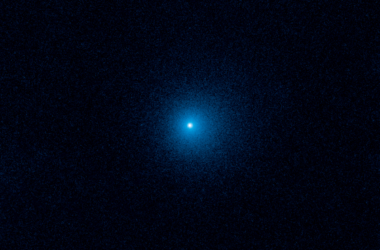
Dans cette illustration, un trou noir arrache de la matière à une étoile voisine pour la placer dans un disque d’accrétion. Crédit : Aurore Simonnet et le Goddard Space Flight Center de la NASA.
Les nouvelles découvertes aideront les scientifiques à retracer un black hole’s evolution as it feeds on stellar material.
Tens of millions of black holes are strewn across our Milky Way galaxy. These gravitational wells of spacetime are so enormously powerful that infalling matter, and even light, can never escape. Except on rare instances when they feed, black holes are inherently dark. As a black hole absorbs gas and dust from an orbiting star, it can emit stunning bursts of X-ray radiation that bounce and reverberate off the inspiraling gas, briefly illuminating a black hole’s extreme surroundings.
Now MIT astronomers are looking for flashes and echoes from nearby black hole X-ray binaries — systems with a star orbiting, and occasionally being eaten away by, a black hole. They are analyzing the echoes from such systems to reconstruct a black hole’s immediate, extreme vicinity.
In a study appearing published on May 2, 2022, in The Astrophysical Journal, the researchers report using a new automated search tool, which they’ve named the “Reverberation Machine,” to comb through satellite data for signs of black hole echoes. In their search, they have discovered eight new echoing black hole binaries in our galaxy. Previously, only two such systems in the Milky Way were known to emit X-ray echoes.
In comparing the echoes across systems, the team has pieced together a general picture of how a black hole evolves during an outburst. Across all systems, they observed that a black hole first undergoes a “hard” state, whipping up a corona of high-energy photons along with a jet of relativistic particles that is launched away at close to the speed of light. The researchers discovered that at a certain point, the black hole gives off one final, high-energy flash, before transitioning to a “soft,” low-energy state.
This final flash may be a sign that a black hole’s corona, the region of high-energy plasma just outside a black hole’s boundary, briefly expands, ejecting a final burst of high-energy particles before disappearing entirely. These findings could help to explain how larger, supermassive black holes at the center of a galaxy can eject particles across vastly cosmic scales to shape a galaxy’s formation.
“The role of black holes in galaxy evolution is an outstanding question in modern astrophysics,” says Erin Kara, assistant professor of physics at MIT. “Interestingly, these black hole binaries appear to be ‘mini’ supermassive black holes, and so by understanding the outbursts in these small, nearby systems, we can understand how similar outbursts in supermassive black holes affect the galaxies in which they reside.”
The study’s first author is MIT graduate student Jingyi Wang; other co-authors include Matteo Lucchini and Ron Remillard at MIT, along with collaborators from Caltech and other institutions.
X-ray delays
Kara and her colleagues are using X-ray echoes to map a black hole’s vicinity, much the way that bats use sound echoes to navigate their surroundings. When a bat emits a call, the sound can bounce off an obstacle and return to the bat as an echo. The time it takes for the echo to return is relative to the distance between the bat and the obstacle, giving the animal a mental map of its surroundings.
In a similar fashion, the MIT team is looking to map the immediate vicinity of a black hole using X-ray echoes. The echoes represent time delays between two types of X-ray light: light emitted directly from the corona, and light from the corona that bounces off the accretion disk of inspiraling gas and dust.
The time when a telescope receives light from the corona, compared to when it receives the X-ray echoes, gives an estimate of the distance between the corona and the accretion disk. Watching how these time delays change can reveal how a black hole’s corona and disk evolve as the black hole consumes stellar material.
Echo evolution
In their new study, the team developed a search algorithm to comb through data taken by NASA’s Neutron star Interior Composition Explorer, or NICER, a high-time-resolution X-ray telescope aboard the International Space Station. The algorithm picked out 26 black hole X-ray binary systems that were previously known to emit X-ray outbursts. Of these 26, the team found that 10 systems were close and bright enough that they could discern X-ray echoes amid the outbursts. Eight of the 10 were previously not known to emit echoes.
“We see new signatures of reverberation in eight sources,” Wang says. “The black holes range in mass from five to 15 times the mass of the sun, and they’re all in binary systems with normal, low-mass, sun-like stars.”
As a side project, Kara is working with MIT education and music scholars, Kyle Keane and Ian Condry, to convert the emission from a typical X-ray echo into audible sound waves. Take a listen to the sound of a black hole echo here:
Crédit : Son calculé par Kyle Keane et Erin Kara, MIT. Animation calculée par Michal Dovciak, ASU CAS.
Les chercheurs ont ensuite appliqué l’algorithme aux 10 trous noirs binaires et ont divisé les données en groupes présentant des “caractéristiques spectrales temporelles” similaires, c’est-à-dire des délais similaires entre les rayons X à haute énergie et les échos retraités. Cela a permis de suivre rapidement le changement des échos de rayons X à chaque étape de l’explosion d’un trou noir.
L’équipe a identifié une évolution commune à tous les systèmes. Dans l’état initial “dur”, dans lequel une couronne et un jet de particules de haute énergie dominent l’énergie du trou noir, ils ont détecté des décalages temporels courts et rapides, de l’ordre de la milliseconde. Cet état dur dure pendant plusieurs semaines. Ensuite, une transition se produit sur plusieurs jours, au cours de laquelle la couronne et le jet se pulvérisent et s’éteignent, et un état mou prend le relais, dominé par des rayons X de plus faible énergie provenant du disque d’accrétion du trou noir.
Au cours de cette transition entre l’état dur et l’état mou, l’équipe a découvert que les décalages temporels se sont momentanément allongés dans les 10 systèmes, ce qui implique que la distance entre la couronne et le disque s’est également accrue. Une explication est que la couronne peut s’étendre brièvement vers l’extérieur et vers le haut, dans un dernier sursaut de haute énergie avant que le trou noir ne finisse la majeure partie de son repas stellaire et ne devienne silencieux.
“Nous commençons à être en mesure d’utiliser ces échos lumineux pour reconstituer les environnements les plus proches du trou noir”, explique Kara. “Maintenant, nous avons montré que ces échos sont couramment observés, et nous sommes en mesure de sonder les connexions entre le disque, le jet et la couronne d’un trou noir d’une nouvelle manière.”
Référence : “La “machine à réverbération” NICER : A Systematic Study of Time Lags in Black Hole X-Ray Binaries” par Jingyi Wang, Erin Kara, Matteo Lucchini, Adam Ingram, Michiel van der Klis, Guglielmo Mastroserio, Javier A. García, Thomas Dauser, Riley Connors, Andrew C. Fabian, James F. Steiner, Ron A. Remillard, Edward M. Cackett, Phil Uttley et Diego Altamirano, 2 mai 2022, The Astrophysical Journal.
DOI : 10.3847/1538-4357/ac6262
Cette recherche a été soutenue, en partie, par la NASA.



